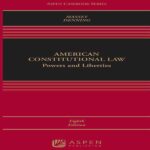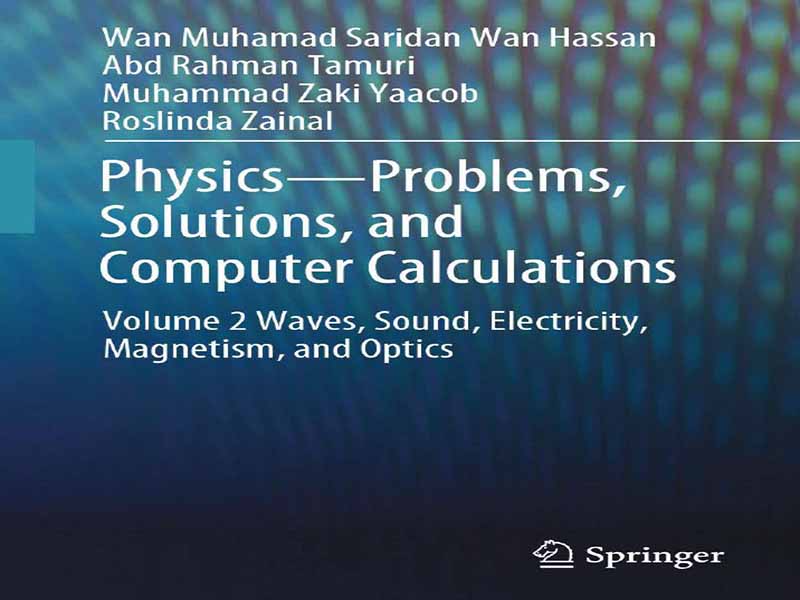- عنوان کتاب: Physics—Problems, Solutions, and Computer Calculations -Volume 2: Waves, Sound, Electricity, Magnetism, and Optics
- نویسنده: Wan Muhamad Saridan Wan Hassan
- حوزه: امواج الکترومغناطیس
- سال انتشار: 2023
- تعداد صفحه: 583
- زبان اصلی: انگلیسی
- نوع فایل: pdf
- حجم فایل: 14.8 مگابایت
این کتاب، یک کتاب مطالعه فیزیک مقدماتی است. این کتاب مفاهیم و اصول اولیه فیزیک مقدماتی را به دانشجویان علوم و مهندسی ارائه میدهد و مسائل و راهحلهای آنها را با محاسبات تحلیلی و کامپیوتری ارائه میدهد. این کتاب برای یادگیری فیزیک مقدماتی در اوایل تحصیلات دانشگاهی در مقطع کارشناسی است. مباحث فیزیک مقدماتی به دو جلد تقسیم میشوند: جلد اول: مکانیک، خواص ماده و گرما جلد دوم: امواج، صدا، الکتریسیته، مغناطیس و اپتیک – که جلد حاضر است. هر فصل با نکات اصلی موضوع آغاز میشود. اینها خلاصهای از مفاهیم، اصول، تعاریف و فرمولهای موضوع هستند. سپس، مسائل مطرح و حل میشوند. مراحل به تفصیل شرح داده شدهاند تا استدلال و درک ایجاد شود. شکلهای زیادی برای کمک به تجسم مسائل و راهحلهای فیزیک رسم شدهاند. محاسبات و راهحلها نیز توسط کامپیوتر با استفاده از wxMaxima انجام میشوند تا مهارتهای محاسباتی را القا کنند. ضمیمهای با عنوان مقدمهای بر wxMaxima برای شروع کار دانشجویان با نرمافزار گنجانده شده است. محاسبات توسط wxMaxima خود به راهحلها دست یافتند یا برای بررسی مجدد مقادیر بهدستآمده بهصورت تحلیلی استفاده شدند. باور ما این است که موفقیت در حل مسائل فیزیک از طریق تحلیل یا محاسبه کامپیوتری، اعتماد به نفس و انگیزه، حس پیروزی و حس «من میتوانم این را انجام دهم، بگذار دیگری را امتحان کنم» را افزایش میدهد. در محاسبات کامپیوتری، تغییر مقادیر چند کمیت فیزیکی و انجام مجدد محاسبه ممکن است صحنه فیزیکی را به صحنهای جدید یا به موقعیتی دشوار برای درک تبدیل کند. ما وسوسه میشویم که صحنههای فیزیکی مختلف را کشف و آزمایش کنیم و خلاق باشیم، البته با کامپیوتر. فصل 1 به حل مسائل مربوط به امواج سیار، معادلات موج و امواج هارمونیک میپردازد. دامنه، فرکانس زاویهای، ثابت انتشار، سرعت و جهت حرکت موج از معادله آن تعیین میشوند. انیمیشنهای امواج سیار ارائه میشوند. فصل 2 به حل مسائل مربوط به امواج صوتی در هوا، جابجایی آنها و امواج فشار میپردازد. سرعت صوت در محیطهای مختلف، شدت و سطح شدت صوت در نظر گرفته میشود. اثرات داپلر ناشی از حرکت نسبی منبع صدا و ناظر نیز مورد بحث قرار میگیرد. مسائل مربوط به برهمنهی امواج و امواج ثابت در فصل 3 حل میشوند. این مسائل شامل امواج ثابت در ستون هوا و ریسمان میشوند. گرهها و آنتیگرههای امواج ساکن شناسایی شدهاند. انیمیشنهایی از این امواج ساکن برای درک بهتر فیزیک ارائه شده است. مسائل مربوط به الکتریسیته در فصلهای ۴ تا ۹ حل شدهاند. فصل ۴ به مسائل مربوط به بار الکتریکی، نیروی الکترواستاتیک و میدان الکتریکی میپردازد. از جمع برداری و روشهای حساب دیفرانسیل و انتگرال برای محاسبه برخی از میدانهای الکتریکی استفاده میشود. فصل ۵ به حل مسائل مربوط به قانون گاوس و کاربرد آن میپردازد. قانون گاوس بیان میکند که شار الکتریکی عبوری از یک سطح بسته برابر است با بار الکتریکی محصور شده توسط سطح تقسیم بر گذردهی فضای آزاد. با استفاده از قانون گاوس، میدانهای الکتریکی برخی از توزیعهای بار متقارن محاسبه میشوند. فصل ۶ به حل مسائل مربوط به انرژی پتانسیل الکتریکی، اختلاف پتانسیل الکتریکی و پتانسیل الکتریکی میپردازد. هر نقطه در ناحیهای از میدان الکتریکی با یک پتانسیل الکتریکی مرتبط است که انرژی پتانسیل الکتریکی به ازای واحد بار در آن نقطه است. فصل ۷ به بحث در مورد مسائل مربوط به ظرفیت، ظرفیت معادل خازنهای سری و موازی و انرژی در خازنهای باردار میپردازد. همچنین در مورد تأثیر قرار دادن ماده دیالکتریک بین صفحات خازن بحث میشود. فصل ۸ به حل مسائل مربوط به جریان الکتریکی، چگالی جریان، مقاومت، مقاومت ویژه و قانون اهم میپردازد. مسائل مربوط به افزایش مقاومت به دلیل افزایش دما، ضریب دمای مقاومت و اتلاف توان الکتریکی توسط مقاومتها نیز حل میشوند. فصل ۹ با اعمال قوانین کیرشهف، مسائل مربوط به مدارهای جریان مستقیم را حل میکند. این قوانین عبارتند از (۱) مجموع جریانهای ورودی به هر نقطه اتصال صفر است و (۲) مجموع اختلاف پتانسیلهای دو سر هر عنصر در اطراف یک حلقه بسته صفر است. مسائلی برای تعیین مقاومت معادل مقاومتهای سری و موازی و تعیین جریان و بار در مدارهای RC جریان مستقیم نیز مورد بررسی قرار میگیرند. مسائل مربوط به مغناطیس در فصلهای ۱۰ تا ۱۴ حل شدهاند. مسائل مربوط به نیروهای مغناطیسی ناشی از حرکت ذرات باردار و رساناهای حامل جریان در میدانهای مغناطیسی در فصل ۱۰ حل شدهاند. گشتاور ناشی از گشتاور مغناطیسی حلقه حامل جریان در میدان مغناطیسی نیز مورد بحث قرار گرفته است. فصل ۱۱ به حل مسائل مربوط به میدانهای مغناطیسی ایجاد شده توسط رساناها و حلقههای حامل جریان میپردازد. قانون بیو-ساوار برای تعیین میدانهای مغناطیسی اعمال میشود. میدانهای مغناطیسی در یک سلونوئید و چنبره حامل جریان با اعمال قانون آمپر تعیین میشوند. مسائل مربوط به مواد مغناطیسی و چگونگی تأثیر القای مغناطیسی، قدرت میدان مغناطیسی و مغناطش هنگام قرار دادن مواد در هسته سلونوئید و چنبره حامل جریان در فصل ۱۲ حل شدهاند. فصل ۱۳ مسائل مربوط به … را حل میکند…
The book is an introductory physics study book. The book offers students of science and engineering the basic concepts and principles of introductory physics, presenting problems and their solutions by analytical and computer calculations. It is for introductory physics learning at early undergraduate university education. The introductory physics topics are divided into two volumes: Volume I Mechanics, properties of matter, and heat Volume II Waves, sound, electricity, magnetism, and optics—which is the present volume. Each chapter begins with the main points of the topic. These are summaries of concepts, principles, definitions, and formulae of the topic. Then, problems are posed and solved. Steps are detailed so that reasoning and understanding are built. Many figures are drawn to help in visualizing the physics problems and solutions. Calculations and solutions are also performed by computer using wxMaxima to instill computational skills. An appendix Introduction to wxMaxima is included to get students started with the software. Calculations by wxMaxima achieved the solutions themselves or for rechecking the values obtained analytically. Our belief is that success in solving physics problems by analysis or computer calculation boosts confidence and motivation, a sense of victory, and a sense of “I can do this, let me try the other”. In computer calculation, changing the values of a few physical quantities and redoing the calculation might change the physical scene into a new one or into a hard to comprehend situation. We are tempted to explore and experiment with different physical scenes and be creative, albeit by computer. Chapter 1 solves problems on traveling waves, wave equations, and harmonic waves. Amplitude, angular frequency, propagation constant, speed, and direction of travel of the wave are determined from its equation. Animations of traveling waves are presented. Chapter 2 solves problems on sound waves in air, their displacement, and pressure waves. Speed of sound in various media, intensity, and intensity level of sound are considered. Doppler’s effects due to the relative motion of the sound source and observer are also discussed. Problems on the superposition of waves and stationary waves are solved in Chap. 3. These include stationary waves in air column and string. Nodes and antinodes of the stationary waves are identified. Animations of these stationary waves are presented for insight into the physics. Problems on electricity are solved in Chaps. 4–9. Chapter 4 discusses problems on electric charge, electrostatic force, and electric field. Vector additions and methods of calculus are used to calculate some of the electric fields. Chapter 5 solves problems on Gauss’s law and its application. Gauss’s law states that electric flux through a closed surface is equal to the electric charge enclosed by the surface divided by the permittivity of free space. Using Gauss’s law, electric fields of some symmetric charge distributions are calculated. Chapter 6 solves problems on electric potential energy, electric potential difference, and electric potential. Every point in a region of an electric field is associated with an electric potential which is electric potential energy per unit charge at the point. Chapter 7 discusses problems on capacitance, equivalent capacitance of capacitors in series and parallel, and energy in charged capacitors. Also discussed is the effect of inserting dielectric material between plates of capacitor. Chapter 8 solves problems on electric current, current density, resistance, resistivity, and Ohm’s law. Problems on increase in resistance due to rise in temperature, resistance temperature coefficient, and dissipation of electrical power by resistors are also solved. Chapter 9 solves problems on direct current circuits by applying Kirchhoff’s rules. The rules are (1) the sum of the currents into any junction is zero, and (2) the sum of potential differences across each element around a closed loop is zero. Problems to determine equivalent resistance of resistors in series and in parallel and to determine current and charge in direct current RC circuits are also tackled. Problems on magnetism are solved in Chaps. 10–14. Problems on magnetic forces due to moving charged particles and current carrying conductors in magnetic fields are solved in Chap. 10. The torque due to the magnetic moment of current carrying loop in magnetic field is also discussed. Chapter 11 solves problems on magnetic fields created by current carrying conductors and loops. The Biot–Savart law is applied to determine the magnetic fields. Magnetic fields in a current carrying solenoid and toroid are determined by applying Ampere’s law. Problems related to magnetic materials and how magnetic induction, magnetic field strength, and magnetization are affected when the materials are inserted in the core of current carrying solenoid and toroid are solved in Chap. 12. Chapter 13 solves problems related to emf induced by changing the magnetic flux. Faraday’s law states that the emf induced is equal to the negative time rate of change of the magnetic flux. Emf is induced in a moving conductor when the conductor cuts through the magnetic field lines. Emf is also induced in a rotating conducting loop when the loop cuts through the magnetic field lines. Chapter 14 solves problems on electric inductance—a measure of resistance of a conducting coil to change in current or magnetic flux linkages per unit current of the coil. Problems on self- and mutual inductance, energy in inductor, and direct current RL circuit are solved. Chapter 15 solves problems on series RLC alternating current circuits. Inductive and capacitive reactance, impedance, phase angle, power factor, root mean square current, and average power of the circuits are determined. Chapter 16 solves problems on plane electromagnetic wave, associated Poynting vector, and radiation pressure. These include the determination of electric and magnetic field amplitudes and directions, intensity, energy density, and direction of propagation of the electromagnetic waves. An animation of a traveling plane electromagnetic wave is presented. Problems on geometrical or ray optics are solved in Chaps. 17 and 18. Chapter 17 solves problems on light reflection, refraction, total internal reflection, dispersion, and polarization. Chapter 18 solves problems on image formation by mirrors, spherical surfaces, and lenses using geometrical or ray optics. Calculations of image size, location, and magnification are performed. Spherical mirror, refraction at a spherical surface, lens maker, and thin lens equations are applied. Problems on wave optics are solved in Chaps. 19 and 20. Chapter 19 solves problems on interference of light, a phenomenon due to the superposition of coherent lights. These include interference in Young’s double-slit experiment, thin film, lens coating, air wedge, and Newton’s rings experiment. Problems on diffraction of light are solved in Chap. 20, the last chapter. Diffraction is the bending or spreading of light at an aperture or obstacle. Problems on diffraction by a single slit and diffraction by a grating and its resolving power are discussed. We wish to acknowledge the advice from several of our colleagues and undergraduate students on the idea of the book. We are also grateful to the editorial staff of Springer Nature for their support.
این کتاب را میتوانید از لینک زیر بصورت رایگان دانلود کنید:
Download: Physics—Problems, Solutions, and Computer Calculations -Volume 2



































نظرات کاربران